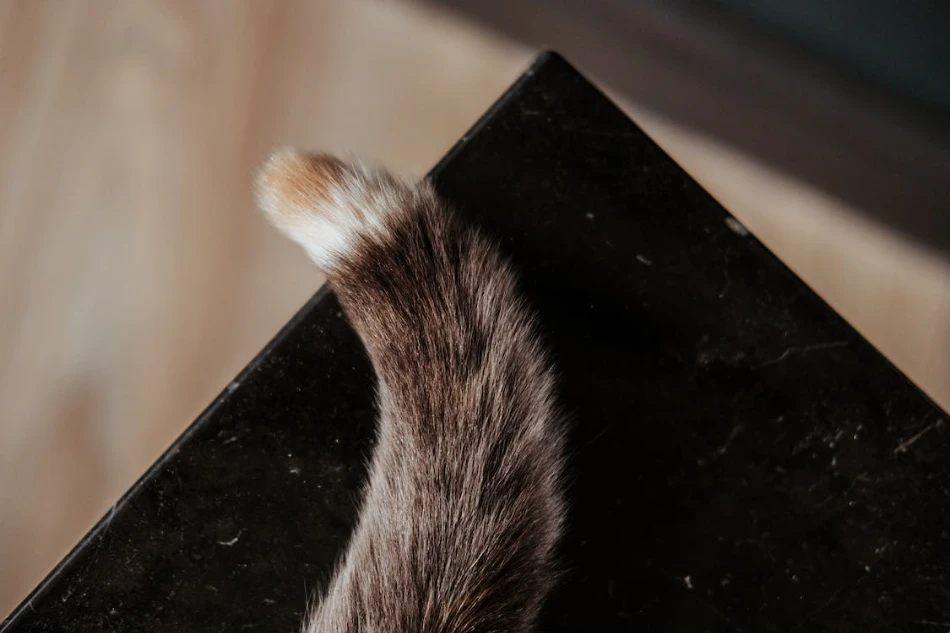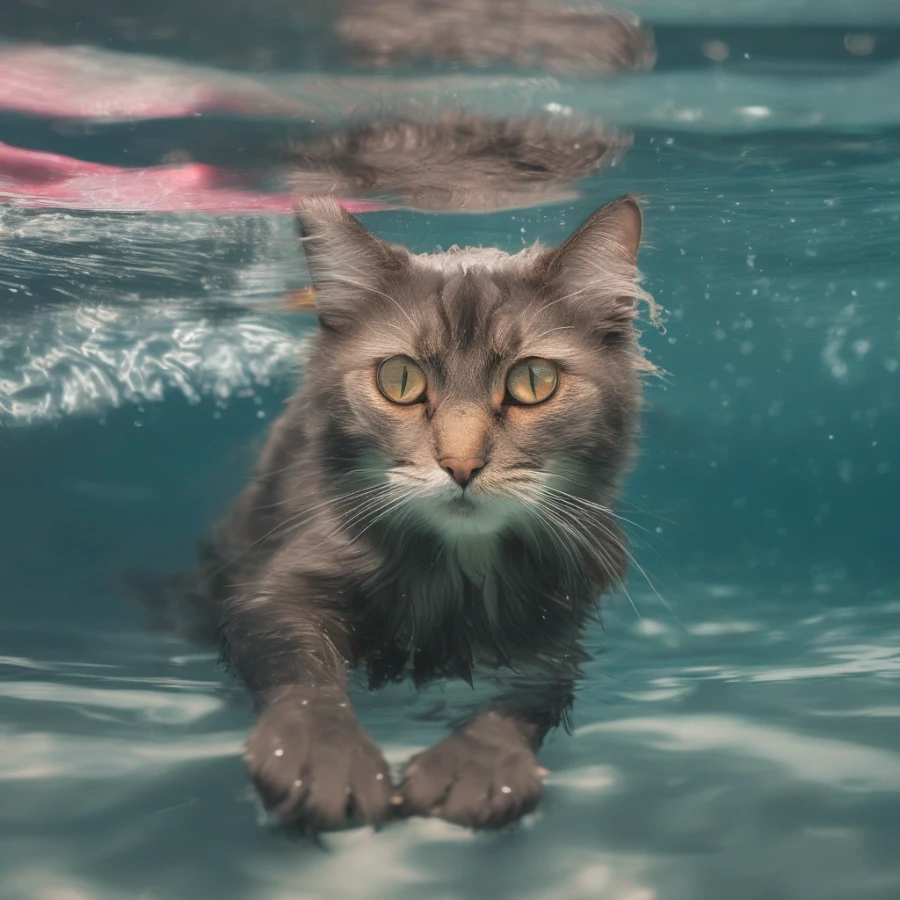Exploring Cat Tail Loss: Causes, Prevention, and Care

Published by: Tatsiana Korshik
Time to Read: 3 Min

Cats are renowned for their graceful and agile movements, with their tails often playing a crucial role in balance and communication. However, have you ever wondered why cats' tails sometimes fall off or experience injury? In this comprehensive blog post, we'll unravel the mysteries behind cat tail loss, exploring the various factors that can cause this phenomenon, how to prevent it, and the essential care required when it happens.
Balance: Cats' tails act as counterbalances, helping them maintain stability during complex movements, such as leaping, climbing, or walking on narrow surfaces.
Communication: A cat's tail is a key element of its communication system. Tail positions and movements convey emotions and intentions, from happiness and curiosity to fear and aggression.
Temperature Regulation: In cold weather, a cat may wrap its tail around its body to conserve heat. Conversely, in hot weather, it can use its tail to dissipate excess heat.
Trauma-Related Tail Loss
Accidents: Cats can experience tail injuries due to accidents, such as getting their tails caught in doors, under heavy objects, or in car accidents.
Bites and Fights: Cat fights or attacks from other animals can lead to tail injuries or even tail loss.
Tail Amputation: In some cases, veterinarians may need to amputate part or all of a cat's tail due to severe injuries or medical conditions.
Tail Infections
Tail infections, often resulting from bites, scratches, or unclean environments, can lead to tail tissue damage and, in extreme cases, necessitate tail amputation.
Tail Necrosis
Tail necrosis is a condition where the tail tissue dies due to inadequate blood supply. This can be caused by conditions like frostbite, infections, or certain diseases.
Congenital Issues Some cats are born with abnormalities in their tails, which can lead to issues like tail deformities or, in rare cases, tail loss.
To prevent accidental tail injuries, keep a watchful eye on your cat, especially when doors are closing or when there are potential hazards in the environment. Install safety measures like doorstops or slow-closing hinges to prevent tail entrapment.
Veterinary Care
Regular veterinary check-ups are crucial for early detection of tail issues. If your cat experiences any injuries or infections, seek prompt veterinary care to prevent complications.
Hygiene and Cleanliness
Maintain proper hygiene in your cat's living area to reduce the risk of infections. Regularly clean litter boxes and ensure that your cat's environment is free from harmful bacteria.
Parasite Control
Prevent fleas and ticks, which can lead to itchy tails and excessive scratching. Consult your veterinarian for appropriate parasite control measures.
Behavioral Training
Address aggressive or territorial behaviors that can lead to cat fights, which may result in tail injuries. Consult with a professional animal behaviorist if needed.
Conclusion
While cat tail loss can be a distressing event for both the cat and its owner, understanding the causes, prevention methods, and appropriate care is essential for ensuring the best possible outcome. Cats are remarkably resilient creatures, and with proper care and attention, they can adapt to tail loss and continue to lead happy and fulfilling lives. Always consult with a veterinarian for guidance on tail injuries and treatment options tailored to your cat's specific needs.
A cat's tail serves several vital functions, including balance, communication, and temperature regulation. It helps cats maintain stability during various movements, conveys their emotions and intentions, and assists in regulating body temperature.
Can a cat's tail fall off naturally?
No, a cat's tail does not fall off naturally. Tail loss typically occurs due to specific causes, such as accidents, injuries, infections, or medical conditions.
What are some common types of cat tail injuries?
Common types of cat tail injuries include accidents (like getting caught in doors), bites and fights with other animals, tail infections, tail necrosis (tissue death), and congenital issues present from birth.
Is tail amputation common in cats?
Tail amputation is not common in cats and is typically performed as a last resort in cases of severe tail injuries or medical conditions where preservation of the tail is not possible.
How can I prevent tail injuries in my cat?
To prevent tail injuries, it's essential to supervise your cat, especially in situations where tail entrapment might occur, such as closing doors. Installing safety measures like doorstops or slow-closing hinges can help minimize the risk.
What should I do if my cat experiences a tail injury?
If your cat experiences a tail injury, seek immediate veterinary care. Early diagnosis and treatment can prevent complications and promote faster healing.
Are there any specific hygiene practices to prevent tail infections?
Maintaining proper hygiene in your cat's living area, regularly cleaning litter boxes, and ensuring a clean environment can reduce the risk of tail infections. Keep an eye out for any signs of infection, such as redness, swelling, or discharge.
How can I control fleas and ticks to protect my cat's tail?
Consult your veterinarian for suitable parasite control measures to prevent fleas and ticks, which can lead to itchy tails and excessive scratching. They can recommend safe and effective products for your cat.
What can I do to address aggressive or territorial behaviors in my cat?
To address aggressive or territorial behaviors that might lead to cat fights and tail injuries, consult with a professional animal behaviorist. They can provide guidance and training techniques to help modify your cat's behavior.
Can a cat adapt to tail loss and lead a normal life?
Cats are remarkably adaptable, and with proper care and attention, they can adapt to tail loss and continue to lead happy and fulfilling lives. Tail loss may affect balance and communication, but most cats can adjust over time.
Understanding Cat Tails
Before diving into the topic of tail loss, let's first understand the importance of a cat's tail. The tail serves several critical functions, including:Balance: Cats' tails act as counterbalances, helping them maintain stability during complex movements, such as leaping, climbing, or walking on narrow surfaces.
Communication: A cat's tail is a key element of its communication system. Tail positions and movements convey emotions and intentions, from happiness and curiosity to fear and aggression.
Temperature Regulation: In cold weather, a cat may wrap its tail around its body to conserve heat. Conversely, in hot weather, it can use its tail to dissipate excess heat.
Cat Tail Loss: Causes and Types
Cat tail loss can result from various causes, each requiring a different approach to care and prevention. Here are some common causes and types:Trauma-Related Tail Loss
Accidents: Cats can experience tail injuries due to accidents, such as getting their tails caught in doors, under heavy objects, or in car accidents.
Bites and Fights: Cat fights or attacks from other animals can lead to tail injuries or even tail loss.
Tail Amputation: In some cases, veterinarians may need to amputate part or all of a cat's tail due to severe injuries or medical conditions.
Tail Infections
Tail infections, often resulting from bites, scratches, or unclean environments, can lead to tail tissue damage and, in extreme cases, necessitate tail amputation.
Tail Necrosis
Tail necrosis is a condition where the tail tissue dies due to inadequate blood supply. This can be caused by conditions like frostbite, infections, or certain diseases.
Congenital Issues Some cats are born with abnormalities in their tails, which can lead to issues like tail deformities or, in rare cases, tail loss.
Prevention and Care
Supervision and Safety MeasuresTo prevent accidental tail injuries, keep a watchful eye on your cat, especially when doors are closing or when there are potential hazards in the environment. Install safety measures like doorstops or slow-closing hinges to prevent tail entrapment.
Veterinary Care
Regular veterinary check-ups are crucial for early detection of tail issues. If your cat experiences any injuries or infections, seek prompt veterinary care to prevent complications.
Hygiene and Cleanliness
Maintain proper hygiene in your cat's living area to reduce the risk of infections. Regularly clean litter boxes and ensure that your cat's environment is free from harmful bacteria.
Parasite Control
Prevent fleas and ticks, which can lead to itchy tails and excessive scratching. Consult your veterinarian for appropriate parasite control measures.
Behavioral Training
Address aggressive or territorial behaviors that can lead to cat fights, which may result in tail injuries. Consult with a professional animal behaviorist if needed.
Conclusion
While cat tail loss can be a distressing event for both the cat and its owner, understanding the causes, prevention methods, and appropriate care is essential for ensuring the best possible outcome. Cats are remarkably resilient creatures, and with proper care and attention, they can adapt to tail loss and continue to lead happy and fulfilling lives. Always consult with a veterinarian for guidance on tail injuries and treatment options tailored to your cat's specific needs.
FAQs about Exploring Cat Tail Loss
What are the main functions of a cat's tail?A cat's tail serves several vital functions, including balance, communication, and temperature regulation. It helps cats maintain stability during various movements, conveys their emotions and intentions, and assists in regulating body temperature.
Can a cat's tail fall off naturally?
No, a cat's tail does not fall off naturally. Tail loss typically occurs due to specific causes, such as accidents, injuries, infections, or medical conditions.
What are some common types of cat tail injuries?
Common types of cat tail injuries include accidents (like getting caught in doors), bites and fights with other animals, tail infections, tail necrosis (tissue death), and congenital issues present from birth.
Is tail amputation common in cats?
Tail amputation is not common in cats and is typically performed as a last resort in cases of severe tail injuries or medical conditions where preservation of the tail is not possible.
How can I prevent tail injuries in my cat?
To prevent tail injuries, it's essential to supervise your cat, especially in situations where tail entrapment might occur, such as closing doors. Installing safety measures like doorstops or slow-closing hinges can help minimize the risk.
What should I do if my cat experiences a tail injury?
If your cat experiences a tail injury, seek immediate veterinary care. Early diagnosis and treatment can prevent complications and promote faster healing.
Are there any specific hygiene practices to prevent tail infections?
Maintaining proper hygiene in your cat's living area, regularly cleaning litter boxes, and ensuring a clean environment can reduce the risk of tail infections. Keep an eye out for any signs of infection, such as redness, swelling, or discharge.
How can I control fleas and ticks to protect my cat's tail?
Consult your veterinarian for suitable parasite control measures to prevent fleas and ticks, which can lead to itchy tails and excessive scratching. They can recommend safe and effective products for your cat.
What can I do to address aggressive or territorial behaviors in my cat?
To address aggressive or territorial behaviors that might lead to cat fights and tail injuries, consult with a professional animal behaviorist. They can provide guidance and training techniques to help modify your cat's behavior.
Can a cat adapt to tail loss and lead a normal life?
Cats are remarkably adaptable, and with proper care and attention, they can adapt to tail loss and continue to lead happy and fulfilling lives. Tail loss may affect balance and communication, but most cats can adjust over time.



